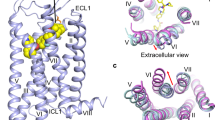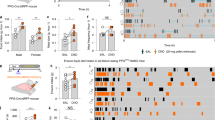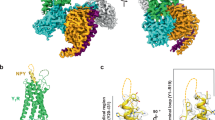Abstract
AIM: These studies were performed to test the hypothesis that endogenous neuropeptide Y (NPY) acting on the NPY Y5 receptor subtype contributes to the control of food intake. The hypothesis was tested using S 25585—a newly synthesized NPY Y5 receptor antagonist.
METHODS AND RESULTS: S 25585 was shown to be a high-affinity antagonist of the NPY Y5 receptor subtype (IC50 5 nM) with no significant affinity toward other NPY receptor subtypes and over 40 other receptors, channels or uptake systems. S 25585 (7.5 mg/kg, i.p.) did not induce a conditioned taste aversion, significantly alter need-induced sodium appetite or induce pica, suggesting that at this dose the compound did not induce illness or malaise. In satiated rats, S 25585 (5.0 and 7.5 mg/kg, i.p.) significantly decreased the overfeeding induced by i.c.v. injection of NPY (1 μg) and the highly selective NPY Y5 receptor agonist [hPP1−17, Ala31, Aib32]NPY (0.7 μg). In rats fasted for 4 h immediately before the dark phase, analysis of the microstructure of feeding behavior revealed that S 25585 significantly increased latency to eat and significantly decreased the duration and size of the meals without altering the meal number or eating rate. Analysis of the behavioral satiety sequence at this time revealed that the animals passed through the normal pattern of feeding, grooming and resting. Although S 25585 appeared to be influencing a physiological system controlling appetite, this does not involve the NPY Y5 receptor since the antagonist also markedly reduced food intake in the NPY Y5 knockout mouse.
CONCLUSIONS: The results presented do not support a role for the NPY Y5 receptor in the control of food intake. The results further illustrate that it is imperative that the activity of any new NPY Y5 antagonist be assessed in the NPY Y5 knockout mouse before assuming that its effect on food intake is due to blockade of this receptor.
This is a preview of subscription content, access via your institution
Access options
Subscribe to this journal
Receive 12 print issues and online access
$259.00 per year
only $21.58 per issue
Buy this article
- Purchase on Springer Link
- Instant access to full article PDF
Prices may be subject to local taxes which are calculated during checkout







Similar content being viewed by others
References
Bivens CL, Thomas WJ, Stanley BG . Similar feeding patterns are induced by perifornical neuropeptide Y injection and by food deprivation. Brain Res 1998; 782: 271–280.
Beck B, Stricker-Krongrad A, Nicolas JP, Burlet C . Chronic and continuous intracerebroventricular infusion of neuropeptide Y in Long–Evans rats mimics the feeding behaviour of obese Zucker rats. Int J Obes Relat Metab Disord 1992; 16: 295–302.
Vettor R, Zarjevski N, Cusin I, Rohner-Jeanrenaud F, Jeanrenaud B . Induction and reversibility of an obesity syndrome by intracerebroventricular neuropeptide Y administration to normal rats. Diabetologia 1994; 37: 1202–1208.
Nicholson SA, Adrian TE, Bacarese-Hamilton AJ, Gillham B, Jones MT, Bloom SR . 24-hour variation in content and release of hypothalamic neuropeptides in the rat. Regul Pept 1983; 7: 385–397.
Dryden S, Burns SJ, Frankish HM, Williams G . Increased hypothalamic neuropeptide Y concentration or hyperphagia in streptozotocin-diabetic rats are not mediated by glucocorticoids. Eur J Pharmacol 1997; 340: 221–225.
Marin-Bivens CL, Kalra SP, Olster DH . Intraventricular injection of neuropeptide Y antisera curbs weight gain and feeding, and increases the display of sexual behaviors in obese Zucker female rats. Regul Pept 1998; 75–76: 327–334.
Hulsey MG, Pless CM, White BD, Martin RJ . ICV administration of anti-NPY antisense oligonucleotide: effects on feeding behavior, body weight, peptide content and peptide release. Regul Pept 1995; 59: 207–214.
Ishihara A, Tanaka T, Kanatani A, Fukami T, Ihara M, Fukuroda T . A potent neuropeptide Y antagonist, 1229U91, suppressed spontaneous food intake in Zucker fatty rats. Am J Physiol 1998; 274: R1500–R1504.
Gehlert DR . Multiple receptors for the pancreatic polypeptide (PP-fold) family: physiological implications. Proc Soc Exp Biol Med 1998; 218: 7–22.
Chamorro S, Della-Zuana O, Fauchère J-C, Félétou M, Galizzi J-P, Levens N . Appetite suppression based on selective inhibition of NPY receptors. Int J Obes Relat Metab Disord 2002; 26: 281–298.
Wyss P, Stricker-Krongrad A, Brunner L, Miller J, Crossthwaite A, Whitebread S, Criscione L . The pharmacology of neuropeptide Y (NPY) receptor-mediated feeding in rats characterizes better Y5 than Y1, but not Y2 or Y4 subtypes. Regul Pept 1998; 75–76: 363–371.
Parker EM, Balasubramaniam A, Guzzi M, Mullins DE, Salisbury BG, Sheriff S, Witten MB, Hwa JJ . D-Trp(34)] neuropeptide Y is a potent and selective neuropeptide Y Y(5) receptor agonist with dramatic effects on food intake. Peptides 2000; 21: 393–399.
Cabrele C, Langer M, Bader R, Wieland HA, Doods HN, Zerbe O, Beck-Sickinger AG . The first selective agonist for the neuropeptide YY5 receptor increases food intake in rats. J Biol Chem 2000; 275: 36043–36048.
McCrea K, Wisialowski T, Cabrele C, Church B, Beck-Sickinger A, Kraegen E, Herzog H . 2-36[K4,RYYSA(19-23)]PP a novel Y5-receptor preferring ligand with strong stimulatory effect on food intake. Regul Pept 2000; 87: 47–58.
Hwa JJ, Witten MB, Williams P, Ghibaudi L, Gao J, Salisbury BG, Mullins D, Hamud F, Strader CD, Parker EM . Activation of the NPY Y5 receptor regulates both feeding and energy expenditure. Am J Physiol 1999; 277 (5 Part 2): R1428–R1434.
Kanatani A, Hata M, Mashiko S, Ishihara A, Okamoto O, Haga Y, Ohe T, Kanno T, Murai N, Ishii Y, Fukuroda T, Fukami T, Ihara M . A typical Y1 receptor regulates feeding behaviors: effects of a potent and selective Y1 antagonist, J-115814. Mol Pharmacol 2001; 59: 501–505.
Naveilhan P, Hassani H, Canals JM, Ekstrand AJ, Larefalk A, Chhajlani V, Arenas E, Gedda K, Svensson L, Thoren P, Ernfors P . Normal feeding behavior, body weight and leptin response require the neuropeptide Y Y2 receptor. Nat Med 1999; 5: 1188–1193.
Flynn MC, Turrin NP, Plata-Salaman CR, Ffrench-Mullen JM . Feeding response to neuropeptide Y-related compounds in rats treated with Y5 receptor antisense or sense phosphothio-oligodeoxynucleotide. Physiol Behav 1999; 66: 881–884.
Schaffhauser AO, Stricker-Krongrad A, Brunner L, Cumin F, Gerald C, Whitebread S, Criscione L, Hofbauer KG . Inhibition of food intake by neuropeptide Y Y5 receptor antisense oligodeoxynucleotides. Diabetes 1997; 46: 1792–1798.
Marsh DJ, Hollopeter G, Kafer KE, Palmiter RD . Role of the Y5 neuropeptide Y receptor in feeding and obesity. Nat Med 1998; 4: 718–721.
Kanatani A, Ishihara A, Iwaasa H, Nakamura K, Okamoto O, Hidaka M, Ito J, Fukuroda T, MacNeil DJ, Van der Ploeg LH, Ishii Y, Okabe T, Fukami T, Ihara M . L-152,804: orally active and selective neuropeptide Y Y5 receptor antagonist. Biochem Biophys Res Commun 2000; 272: 169–173.
Daniels AJ, Grizzle MK, Wiard RP, Matthews JE, Heyer D . Food intake inhibition and reduction in body weight gain in lean and obese rodents treated with GW438014A, a potent and selective NPY-Y5 receptor antagonist. Reg Pept 2002; 106: 47–54.
Feletou M, Nicolas J-P, Rodriguez M, Beauverger P, Galizzi J-P, Boutin J, Duhault J . NPY receptor subtype in the rabbit isolated ileum. Br J Pharmacol 1999; 127: 795–801.
Dumont Y, Cadieux A, Doods H, Pheng LH, Abounader R, Hamel E, Jacques D, Regoli D, Quirion R . BIIE0246, a potent and highly selective non-peptide neuropeptide Y Y(2) receptor antagonist. Br J Pharmacol 2000; 129: 1075–1088.
Criscione L, Rigollier P, Batzl-Hartmann C, Rueger H, Stricker-Krongrad A, Wyss P, Brunner L, Whitebread S, Yamaguchi Y, Gerald C, Heurich RO, Walker MW, Chiesi M, Schilling W, Hofbauer KG, Levens N . Food intake in free-feeding and energy-deprived lean rats is mediated by the neuropeptide Y5 receptor. J Clin Invest 1998; 102: 2136–2145.
Madden LJ, Seeley RJ, Woods SC . Intraventricular neuropeptide Y decreases need-induced sodium appetite and increases pica in rats. Behav Neurosci 1999; 113: 826–832.
Halford JC, Wanninayake SC, Blundell JE . Behavioral satiety sequence (BSS) for the diagnosis of drug action on food intake. Pharmacol Biochem Behav 1998; 61: 159–168.
Marsh DJ, Hollopeter G, Kafer KE, Palmiter RD . Role of the Y5 receptor in feeding and obesity. Nat Med 1998; 4: 718–721.
Kordik CP, Luo C, Zanoni BC, Lovenberg TW, Wilson SJ, Vaidya Crooke JJ, Rosenthal DI, Reitz AB . Pyrazolecarboxamide human neuropeptide Y5 receptor ligands with in vivo antifeedant activity. Bioorg Med Chem Lett 2001; 11: 2287–2290.
Dess NK, Vanderweele DA . Lithium chloride and inescapable, unsignaled tail shock differentially affect meal patterns of rats. Physiol Behav 1994; 56: 203–207.
Lopak V, Eikelboom R . Pair housing induced feeding suppression: individual housing not novelty. Physiol Behav 2000; 71: 329–333.
Parker LA . Rewarding drugs produce taste avoidance, but not taste aversion. Neurosci Biobehav Rev 1995; 19: 143–157.
Stricker EM, Verbalis JG . Central inhibition of salt appetite by oxytocin in rats. Regul Pept 1996; 66: 83–85.
Takeda N, Hasegawa S, Morita M, Horii A, Uno A, Yamatodani A, Matsunaga T . Neuropharmacological mechanisms of emesis I. Effects of antiemetic drugs on motion- and apomorphine-induced pica in rats. Methods Find Exp Clin Pharmacol 1995; 17: 589–590.
Mitchell D, Wells C, Hoch N, Lind K, Woods SC, Mitchell LK . Poison induced pica in rats. Physiol Behav 1976; 17: 691–697.
Halford JC, Wanninayake SC, Blundell JE . Behavioral satiety sequence (BSS) for the diagnosis of drug action on food intake. Pharmacol Biochem Behav 1998; 61: 159–168.
McKibbin PE, Rogers P, Williams G . Increased neuropeptide Y concentrations in the lateral hypothalamic area of the rat after the onset of darkness: possible relevance to the circadian periodicity of feeding behavior. Life Sci 1991; 48: 2527–2533.
Jhanwar-Uniyal M, Beck B, Burlet C, Leibowitz SF . Diurnal rhythm of neuropeptide Y like immunoreactivity in the suprachiasmatic, arcuate and paraventricular nuclei and other hypothalamic sites. Brain Res 1990; 536: 331–334.
Davis JD . The microstructure of ingestive behavior. Ann NY Acad Sci 1989; 575: 106–119.
Lynch WC, Hart P, Babcock AM . Neuropeptide Y attenuates satiety: evidence from a detailed analysis of patterns ingestion. Brain Res 1994; 636: 28–34.
Bonini JA, Jones KA, Adham N, Forray C, Artymyshyn R, Durkin MM, Smith KE, Tamm JA, Boteju LW, Lakhlani PP, Raddatz R, Yao W-J, Ogozalek KL, Boyle N, Kouranova EV, Quan Y, Vaysse PJ, Wetzel JM, Branchek TA, Gerald C, Borowsky B . Identification and characterization of two G protein coupled receptors for neuropeptide FF. J Biol Chem 2000; 275: 39324–39339.
Turnbull AV, Ellershaw L, Masters DJ, Birtles S, Boyer S, Carroll D, Clarkson P, Loxham SJG, McAulay P, Teague JL, Foote KM, Pease JE, Block MH . Selective antagonism of the NPY Y5 receptor does not have a major effect on feeding in rats. Diabetes 2002; 51: 2441–2449.
Author information
Authors and Affiliations
Corresponding author
Rights and permissions
About this article
Cite this article
Della-Zuana, O., Revereault, L., Beck-Sickinger, A. et al. A potent and selective NPY Y5 antagonist reduces food intake but not through blockade of the NPY Y5 receptor. Int J Obes 28, 628–639 (2004). https://doi.org/10.1038/sj.ijo.0802435
Received:
Revised:
Accepted:
Published:
Issue Date:
DOI: https://doi.org/10.1038/sj.ijo.0802435



